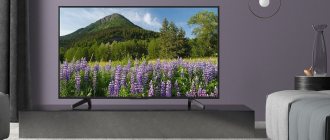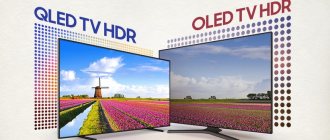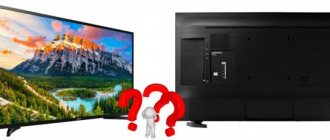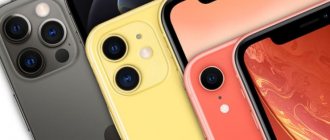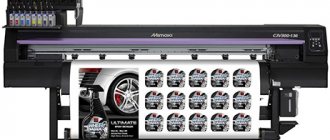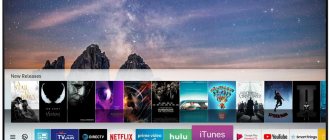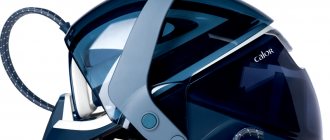Which brand is better - LG, Samsung or Sony?
If you are looking for a new TV, the market is ready to offer you a huge selection.
What is important to you - smart features, advanced screen settings, or compatibility with other devices you already have? Shopping can be overwhelming and the flow of information can be confusing. In such a situation, we suggest that you narrow your search to just one brand. We review dozens of TVs every year, from premium models to the most affordable budget models, and we can confidently say that the differences between individual brands can be huge. The brand name can tell you a lot, such as what smart features may be included, what technology is used to create the panel, and how high-quality the TV is in terms of longevity.
Among the variety of manufacturers today, three main players stand out: LG, Samsung and Sony. Considering that each TV model has its own unique set of advantages and disadvantages, which we always note in our reviews, we will try to compare these giants in this article.
Samsung: Vibrant QLED quality, great smart features
Behind:
- Best-in-Class QLED Displays with Quantum Dot Technology
- Great Smart TV platform
- High degree of integration with home network devices
- Full range of smart features, even in mid-range models
Against:
- Bixby voice assistant is inferior in quality to its competitors Amazon Alexa and Google Assistant
- Instead of Dolby Vision technology, Samsung uses its own HDR10+ technology
Our rating:
- Best Samsung TV: Samsung Q90 QLED
- Best Samsung TV under RUB 60,000: Samsung Q60 QLED
- The best Samsung TV for less than RUB 30,000: Samsung NU7100 124 cm diagonal
Samsung is the world's largest TV manufacturer.
Much of Samsung's dominance comes from its line of QLED models, which are advanced versions of LCD panels with picture quality comparable to OLED and even better in some aspects. When someone says, “I would like to buy an OLED TV, but...”, our advice is always the same: “Check out Samsung QLED TVs as a great alternative.” We installed the new Samsung Q90 QLED next to the LG OLED for comparison and could hardly find any significant differences that would indicate the shortcomings of one or another model. And this despite the fact that Samsung costs significantly less.
Quantum dot technology has enabled Samsung to achieve major improvements in the quality of traditional LED screens. As a result, QLED TVs from Samsung are distinguished by high color and brightness, have a wide viewing angle and provide a vivid picture even in strong lighting conditions.
While mid-range models don't have the benefits of quantum dot technology in the QLED lineup, Samsung's standard LCD TVs are also excellent quality with good levels of brightness, color, and decent HDR performance.
Samsung pays great attention to the aesthetics of its products, taking care of the design of not only the front, but also the back of the TV. And if the regular QLED line doesn’t appeal to you, you should pay attention to the stylish Frame and Serif models, reminiscent of works of art. Less expensive models, such as the 165cm Samsung LED NU6900, are not as flashy, but still have some charm.
However, there is one more parameter that particularly sets Samsung TVs apart - these are smart functions. The Smart TV platform, installed on a wide range of models, from premium class to budget options, offers a large selection of applications and personal settings. The easy-to-navigate interface contains a wealth of possibilities. Plus, some features you can only find on a Samsung TV.
First, there's the Apple TV app, which you don't need to have an Apple device to access. This is an exclusive offer from Samsung that gives you the opportunity to see all your iTunes movies and TV shows on the big screen, as well as watch original programming from the soon-to-be-launched Apple TV channel without having to purchase a separate set-top box.
Samsung also offers unparalleled ease of home network integration, ensuring its TVs are compatible with the entire Samsung SmartThings ecosystem and a wide range of third-party devices. From our point of view, this is the best brand for smart home enthusiasts.
While we recognize the high quality of Samsung TVs, we also note some of their shortcomings. And the biggest among them are akin to self-inflicted injuries. For example, Bixby is Samsung's proprietary voice assistant. While it's not as accurate or fast as Google Assistant or Amazon Alexa, it leaves a pretty good impression when it works. But when it doesn't work, you're frustrated and forced to repeat commands to your remote over and over again, hoping it will finally understand.
Another issue is Samsung's attempt to enter the HDR format war by promoting its own HDR10+ technology. This means that the South Korean giant's TVs do not support the Dolby Vision feature, which many consider to be the leader in quality. As a result, HDR10+ content is limited to a very small selection of Blu-ray discs and streaming video from Amazon Prime, which deprives a large army of TV viewers of the opportunity to enjoy an interesting new visual technology.
LG: Great OLED screens with lots of smart features
Behind:
- Excellent quality of OLED and NanoCell TV series
- The best, in our opinion, smart platform
- Many models are equipped with built-in voice assistants from Google and Amazon
- Premium models feature advanced network solutions
Against:
- The limited brightness of OLED screens can reduce the viewing experience in a well-lit room
- Brightness and HDR quality in NanoCell LCD screens are not always at a high level
Our rating:
- Best LG TV: LG C9 OLED
- The best LG TV for less than RUB 60,000: LG UM7300 4K 165 cm diagonal
- Best LG TV under RUB 30,000: LG UK6300 4K 126 cm diagonal
LG's current OLED lineup includes what we believe is the best model of 2021, the LG C9 OLED, and represents a radical new take on how a modern TV should look and function.
And the new W-Series Wallpaper TV (recently named LG W9 OLED) and Signature Series R Rollable TV (expected in 2020) have become real innovations in design and technology. The advantages of OLED models are undeniable and lie in the excellent combination of color reproduction and the highest backlight accuracy at a level superior to any LCD screen. Controlling the emission of each pixel is the highlight of OLED technology, allowing the display to reflect true blacks and highlight bright parts of HDR frames without blowing out other areas of the image.
LG demonstrates the same high competitiveness in its NanoCell mid-range line that follows OLED. NanoCell technology aims to maximize image quality by controlling the color of each of the screen's 8 million pixels. This nano-level filtering allows for deeper black tones and wider viewing angles, delivering excellent quality for a standard LCD TV.
LG is also the only manufacturer currently equipping its models with HDMI 2.1 ports. The higher bandwidth of version 2.1 allows you to view high frame rate content on your TV, enables VRR (Variable Refresh Rate) for enhanced video game playback, and eARC (Enhanced Audio Return Channel) for lossless audio output.
The LG C9 OLED TV has all four HDMI ports using the new 2.1 version, which is also present in all 2019 OLED models (W9, E9, C9) and NanoCell 4K 9500 and 9000.
LG has made a serious effort to improve the TV's smart features, updating the webOS platform (voted by us as the best TV platform of 2021) and providing access to two built-in voice assistants, Google Assistant and Amazon Alexa. WebOS in the same version as in OLED TVs is also installed on mid-range models produced using LCD technology.
LG TVs are a good choice for those who are particularly demanding about picture quality. With tech features like a built-in calibration template generator, LG models are worthy of Hollywood studios. And special expert screen modes, created with the help of Technicolor and the Imaging Science Foundation (ISF), provide ample opportunities for fine-tuning the screen.
Comparison of characteristics of Sony and Samsung TVs
Sony or Samsung TV, which is better? There are five main criteria on the basis of which equipment is selected:
- color rendering;
- sound purity;
- appearance;
- additional features;
- price.
Image quality
The direct purpose of TV is to display multimedia content, so this parameter plays an important role when choosing a device. Despite the many years of experience and level of assembly of the Japanese brand Sony, Samsung does not lag behind in terms of technical indicators, and also offers customers an improved picture. However, if there is a high level of contrast, it is still inferior to Sony's anti-glare filters. It is noteworthy that the color rendition of the products of these brands is almost the same.
Sony picture quality Samsung picture quality
ColorChecker testing has shown that both manufacturers produce excellent results for checking 24 color shades.
When watching TV, there is a lag, image slowdown, and also jitter and other negative aspects are recorded. These processes are due to the low transmission speed parameter. Accordingly, the higher it is in the model, the better the picture the user receives.
Reference: the latest representatives of the Korean manufacturer’s product line represent a high-contrast quality that is superior to individual representatives of the Japanese developer.
Research indicates that this criterion is almost equal for both manufacturers. In this case, it is possible to select the optimal mode. It is noteworthy that when selecting the “impulsive” mode in Sony representatives, the picture has no complaints, including at the highest speed image movement.
Sound
When comparing Sony and Samsung TVs in terms of sound quality, it should be noted that the first is many times superior in bass saturation. In addition, this implies not only purity, but also volume. This is achieved through built-in acoustic speakers with stereo sound. The second brand equips its products with standard speakers.
Sony surpasses Saisung in bass richness
Design
After studying the characteristics and capabilities of video equipment, buyers pay attention to the appearance. It is noteworthy that Korean developers often borrow ideas from a competitor. Of course, this is not always identical copying, but the similarity of features can be traced.
Samsung developers borrow ideas from the Japanese
It is most difficult for the user to choose a model for a classic interior. Samsung developers offer customers an original, modern design with thoughtful and fundamental lines. Sony fundamentally produces products that comply with the canons of classics and laconicism.
At the same time, the brand’s engineers carefully think through the details - this concerns the location of the logo, case materials, and the stand.
Thus, the Korean plant acts as an innovator, and the Japanese one as a legislator of traditional forms. In fact, both brands are on the same level and often overlap in appearance, although they are endowed with distinctive nuances.
Therefore, to determine which TV is better - Sony or Samsung, you should additionally read the reviews of buyers of this equipment.
Additional functionality
Companies produce products with technologies such as:
- SMART TV;
- 3D;
- 4K.
In view of this, there is no significant difference according to this criterion. However, the equipment runs on different software.
Samsung equips models with Tizen OS, a specially designed software for managing programs and applications.
Tizen OS
Additional advantages:
- Internet access;
- Bluetooth and Wi-Fi functions;
- Allshare option, which is superior in functionality to many competitors;
- synchronization with PC and mobile gadgets;
- clear and convenient interface.
The remote control can be replaced with a smartphone.
Sony uses Google services, and the LCD units run Android TV. This makes it possible to download games, applications and control by voice. Moreover, the products are equipped with useful properties:
- “Picture in Picture” is a mode that allows you to view two channels simultaneously. In this case, one is located across the entire width of the screen, the second - in the form of a small picture in the corner of the monitor. Sports fans love this feature;
- Media content player. A few years ago, this required connecting external devices - video and DVD players. Today, equipment is equipped with USB and HDMI outputs, as well as card readers, which allows you to play files from storage devices;
- Camera, microphone. Modern representatives of the product lines of both brands are equipped with such options. Users can communicate via Skype with friends and family without leaving home.
Android TV
Comparison table to understand which TV is better: Samsung or Sony.
| Technical specifications | Sony | Samsung |
| Display shades, colors | Excellent thanks to anti-glare filters | Decent image |
| Contrast level | High level | Wins, but there is “toxicity” |
| Anti-glare display | Eat | Eat |
| Remote control response speed | 4K | 4K |
| Sound | Acoustic stereo speakers | Standard speakers |
| operating system | Android TV | Tizen O |
The performance of digital equipment is important, as is good build quality. In order for the panel to look ergonomic in your home, and to ensure that watching programs, TV series, and films brings positive emotions, be sure to obtain the following information before purchasing:
- viewing angle;
- optimal distance from TV;
- design integration.
Due to such capabilities, the TV panel turns from a simple television broadcast receiver into a smart, technological device. However, this is not a complete set of amenities provided by video equipment manufacturers.
Price
Budget is an important factor when choosing which TV is better to buy: Samsung or Sony. Regarding models costing no more than 80,000 rubles, you need to understand that they use an LCD screen . It is noteworthy that this is true for both brands. Moreover, each representative of the product line is equipped with a built-in LED backlight, which is why the displays are called liquid crystal displays.
From both manufacturers at a price of less than 80,000 rubles. LCD screen is used
Note: the build quality of Sony video equipment is at a high level, since the products are mounted in Slovakia and Malaysia.
Developers of the Korean brand often use PLS and PVA displays in products. The first technology is installed in inexpensive representatives (up to 20,000 rubles), the second belongs to the middle price category (25,000-35,000 rubles). Naturally, there is no need to talk about a wide viewing angle on PLS screens. It is noteworthy that they also lose in color gamut.
For Sony, the situation is the opposite of its competitor, because the Japanese do not produce very cheap equipment. Therefore, almost every device (with the exception of the premium line from 85,000 rubles) is equipped with a VA matrix of various types. This means that the user receives deep blacks, and in the presence of a bright backlight, high saturation of all shades.
Sony: some of the best (and most expensive) TVs on the market
Behind:
- high quality video processing, creating a clean image and high-quality conversion of low-format material
- high quality acoustics
- the presence of a smart Android TV platform, giving access to a huge collection of applications
- Chromecast and Google Assistant built-in
- special calibration mode for Netflix content
Against:
- prices are higher than competitors
- inconvenient control panel in older models
- complex settings
Our rating:
- Best Sony TV: Sony Master Series A9F OLED
- The best Sony TV under RUB 60,000: Sony XG85 4K 124 cm diagonal
- The best Sony TV under RUB 36,000: Sony XF70 4K 109 cm diagonal
And last in our line, but not the least important, is Sony.
Once the undisputed leader in the audio and video market, Sony is still a highly respected TV manufacturer. And it's no coincidence that the Sony AF9 OLED TV is, in our opinion, the most beautiful TV on the market. Even mid-range models with a standard LCD screen, such as the Sony XG95, provide rich, natural colors thanks to high-quality video processing, support for 10-bit color and HDR format. The AF9 is one of many Sony TVs that boast impeccable pictures, great sound and impressive overall quality. Using the glass panel of the OLED screen as the sound source, advanced Acoustic Surface Audio+ technology creates an immersive experience that leaves TVs with conventional speakers far behind. And Sony's LCD models, like the XG95, create surround sound using a series of multi-directional speakers.
Sony TVs use the smart Android TV platform, which has made serious progress over the past year. The updated version features fast response, a clear interface and a rich set of applications and services from the Google Play Store. The new platform features a full-featured Google Assistant virtual assistant and Chromecast functionality for easily streaming content from mobile devices to your TV. We tested Android TV on the Sony A9F and Sony XG95, and in both cases we were pleased with the results.
However, some persistent problems mar the overall excellent experience of Sony TVs. The settings menu is labyrinthine in complexity, and an added disappointment is that some features are disabled by default. Try connecting a 4K-capable games console to your TV, and you'll have to wade through three or four menu levels before you find how to enable 10-bit color support. Unfortunately, we note that Sony regularly hides some basic settings in the depths of the menu that need to be changed manually.
And finally, as good as Sony TVs are, they are also more expensive than competitors' products. This is especially true for the OLED line, whose price is significantly higher than its analogues from LG. Sony's technology is great, but how many people are willing to pay extra for the same quality and functionality that competitors offer?
Found a mistake? Select it and press ctrl+enter
- 80
Company Features
When choosing between Sony or Samsung, it is important to understand the history and characteristics of each manufacturer. For example, Sony is a Japanese brand with a worldwide reputation and billions of dollars in revenue. The company employs more than 100,000 people, and the success of its activities is due to a responsible approach to each product produced.
Pros of phones:
- Modern design and thoughtful body. A special feature of the brand’s models are square corners. Thanks to them, using the device is more convenient.
- High quality sound. Sony phones are a priori better than many other manufacturers.
- Great cameras. The Japanese manufacturer installs camera modules in smartphones that do an excellent job even in the dark.
- High performance. This factor is due to the use of a more powerful processor.
The only disadvantages that stand out are the high price and a large selection of competitors.
Samsung smartphones are products of a well-known brand that has been operating since 1938. The company always creates something new and pleasantly surprises with many innovations. Pros:
- High quality display.
- Many sensors and additional functions.
- An excellent camera with a wide range of capabilities.
Samsung is better than its competitors in many respects, but, as with Sony, it is let down by its high price.

